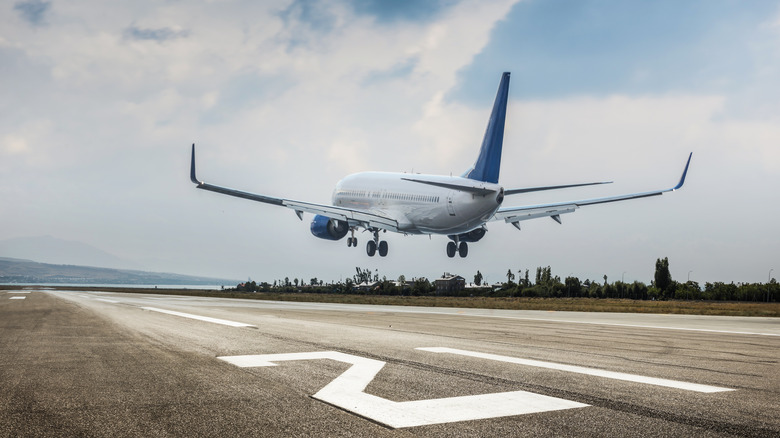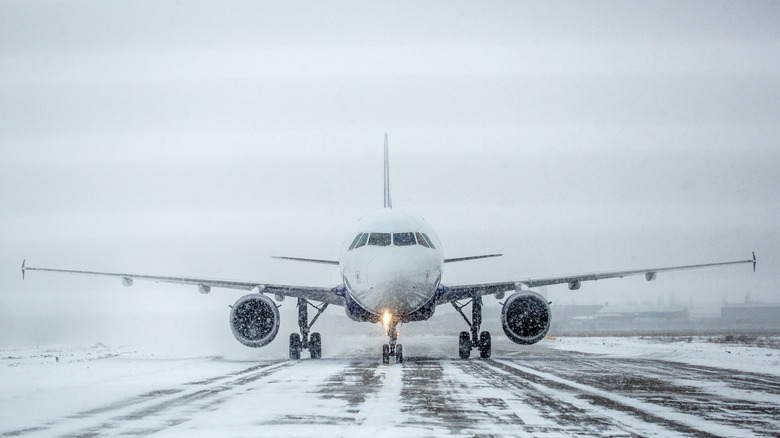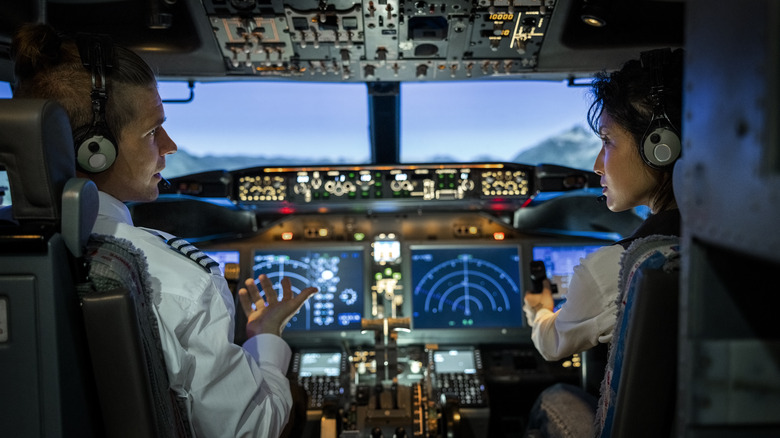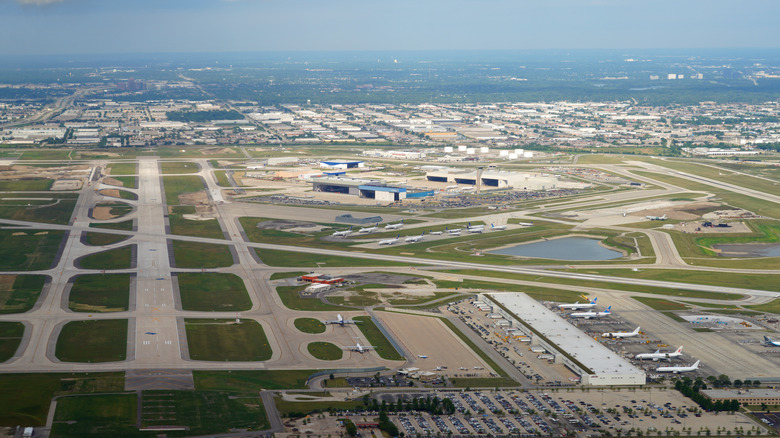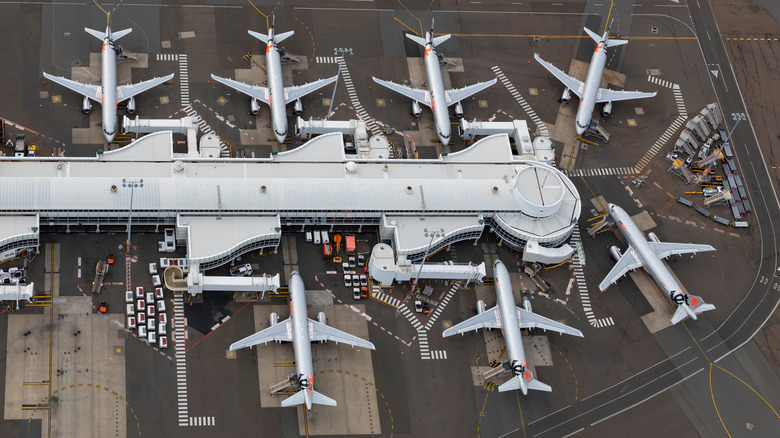Pilots Landing At The Wrong Airport Isn't Quite As Rare As You Think And Here's Why
In an age where air travel is more advanced and safer than ever, the idea of airline pilots landing at the wrong airport seems almost inconceivable. Considering 100,000 flights are landing and taking off every day, this phenomenon, while not common, is not exceptionally rare either. There have been over 150 such landings since the 1990s. Understanding why pilots sometimes land at unintended destinations provides insight into the complexities of aviation and the different factors involved in piloting an aircraft.
One of the primary reasons pilots end up at the wrong airport is the human factor. Even with advanced navigation systems, the final approach and landing are often conducted visually. Like anyone else, pilots can fall victim to optical illusions or misidentifications, especially in areas with multiple airports close to each other. Airports with similar runway orientations or configurations can be easily confused from the air, particularly under conditions of poor visibility or when pilots are under stress or fatigue.
"Ladies and gentlemen, I'm sorry to tell you we landed at the wrong airport," announced the pilot aboard Southwest Flight 4013, flying from Chicago to Branson, Missouri, in January 2014 (via CBC). However, instead of landing at Branson Airport, the flight landed at M. Graham Clark Downtown Airport, a small airport with a runway too small to handle a gargantuan Boeing 737. Confusion arose during a visual approach in the dark, leading the crew to misidentify the airports only 6 miles away from each other. Thankfully, the pilots hit the brakes on time, and everyone was safe.
Air traffic control errors
Sometimes, the pilots aren't to blame at all, but instead, it's air traffic control (ATC). ATC is responsible for guiding aircraft during flight and ensuring their safe arrival at the correct destinations. Errors can occur if controllers misidentify an aircraft's location, give incorrect landing instructions, or if there's a breakdown in communication between the pilots in the cockpit and ATC. These errors can be due to controller workload, misunderstanding of pilot reports, or misinterpretation of radar data. As the adage goes, communication is the key to any relationship — and in the world of aviation, accurate communication is not only key but non-negotiable.
Communication problems between pilots and ATC can factor down to the most minute, yet crucial, detail — the code of the aircraft's flight plan — with serious consequences. Such was the case on one fine September day in 1995 when Northwest Airlines Flight 52 mistakenly landed in Brussels instead of Frankfurt, missing its intended destination by 300 km. The pilots only realized the error upon approaching Brussels but decided to land for safety reasons. Initial confusion was attributed to an incorrect code inputted by an air traffic controller in the aircraft's flight plan. The event was under investigation, with ATC processes and crew actions getting heavily scrutinized. Because of electronic maps tracking the flight in the cabin, "the only people on that plane who didn't know where they were were the three guys up front," remarked an industry connection privy to the investigation (via Washington Post).
Environmental conditions
Buckle up, everyone, inclement weather! Environmental conditions can significantly impact operations, sometimes leading to flights landing at incorrect airports. Factors like fog, heavy rain, snow, or other forms of inclement weather reduce visibility, making it challenging for pilots to visually identify the correct airport, especially during critical phases like landing. At night, these difficulties are compounded. Pilots rely heavily on instruments in such conditions, but misinterpretations or technical issues can still lead to errors.
Sometimes, landings at the wrong airport are made for all the right reasons. Flight DL185, operated by Delta Airlines, experienced a severe hailstorm shortly after takeoff from Milan's Malpensa airport, causing significant damage to the aircraft. As a result, instead of continuing to JFK in New York, the flight made an emergency landing in Rome for the safety of all onboard.
A perplexing landing case attributed to inclement weather (or not?) happened with a domestic United Nigeria Airlines Flight UN504, when it landed in Asaba instead of its intended destination, Abuja. The airline initially claimed the diversion was due to bad weather in Abuja. However, there was evidence that it received the wrong flight plan, and other flights landed in Abuja without issues. The bad-weather explanation did not satisfy the Nigerian Civil Aviation Authority, which suspended the airline's wet-lease operations (where the plane and crew are from other airlines) while the investigation too place. Wrong flight plan? Inclement weather? Human error? Perhaps a little bit of everything.
Technological glitches
Airplanes are a sheer marvel of physics and technology — 36,000 feet in the air, defying gravity, cruising in a metal tube, closer to the bounds of space than the Earth below. With all the fancy equipment onboard, technological glitches, such as malfunctions in navigational aids like GPS or Instrument Landing Systems (ILS), can still lead to flights landing at the wrong airport. These systems are crucial for accurate navigation, and errors in software or hardware can misguide pilots, leading to mistakes. Regular maintenance and software updates are essential to minimize such risks, along with relying on multiple navigation systems and cross-checking data to ensure accuracy.
In 2012, a Sriwijaya Air flight departing from Medan in Indonesia was supposed to land at Minangkabau International Airport. Instead, it landed at Sutan Sjahrir Air Force Base (formerly Tabing Airport) in Padang, 7 miles from the intended destination. Commercial flights had not landed at this military airstrip in over ten years at the time. The pilots explained that they thought the onboard navigation system was malfunctioning during the flight, as it did not match what they saw from the cockpit. Both pilots were suspended; and thankfully, none of the 96 passengers and four crew members were injured. Sometimes smartphone GPS apps make mistakes, but when it's an airplane's GPS, the implications of a "wrong turn" can be far more serious.
Right airport, wrong runway
Something that happens far more often than landing at the wrong airport is landing at the right one, but on the wrong runway. This may seem like a minor mistake, but the consequences can be severe and, in some cases, deadly. Errors can arise from miscommunication between pilots and ATC or misinterpretation of runway markings or lighting (particularly in poor weather or airports with complex runway layouts).
An Iran Air flight IR-449 from Isfahan bound for Tabriz in October 2020 was supposed to land on runway 12L but instead touched down on 12R despite receiving correct landing clearance by ATC. The pilots did not realize they landed on the wrong runway until they received a heavy-handed warning from the traffic control tower. Due to previous flights being cleared for 12R, the captain and first officer apparently "forgot" that this one was cleared for 12L.
An infamous flight now called the "Night Owl" bound from Los Angeles to Mexico City on October 31, 1979 had a tragic ending. Amid terrible weather conditions, Western Airlines Flight 2605 mistakenly landed on a runway closed for maintenance, colliding with construction vehicles and a service building, causing an enormous fire. The accident resulted in 72 fatalities among the 89 people on board, including all three crew members in the cockpit. Investigations attributed the crash to pilot error and poor visibility. This remains one of the deadliest aviation accidents in Mexican history.
A future of right landings
The consequences of a wrong landing are more than just a potentially catastrophic "inconvenience" — travel itineraries, the crew's jobs, and, more importantly, people's lives are at stake. To mitigate these occurrences, aviation authorities and airlines employ various strategies. These include improving pilot training, enhancing GPS and navigation systems, and implementing more rigorous communication protocols between pilots and air traffic controllers. Regular safety audits and sharing information about previous incidents also play a vital role in preventing future occurrences.
The future of correct landings in aviation is likely to be shaped by technological advancements and improved training. Developments in GPS accuracy, automation, and AI could enhance navigational precision. In response to increasing close calls at airports, the Federal Aviation Administration (FAA) is considering mandating technology to alert pilots if they are lined up to land on the wrong runway or when the runway is too short. Many new planes have this technology, but older and private planes do not. Landing at the wrong airport (or runway) is the perfect storm of human, environmental, and technological factors. Hopefully, these developments in the aviation industry will enhance safety, efficiency, and reliability in air travel, making the right landings, every time.
